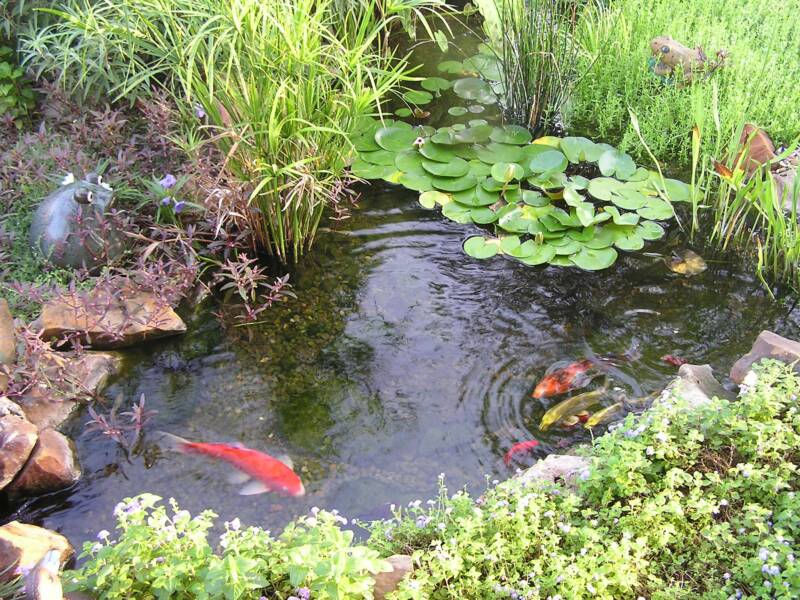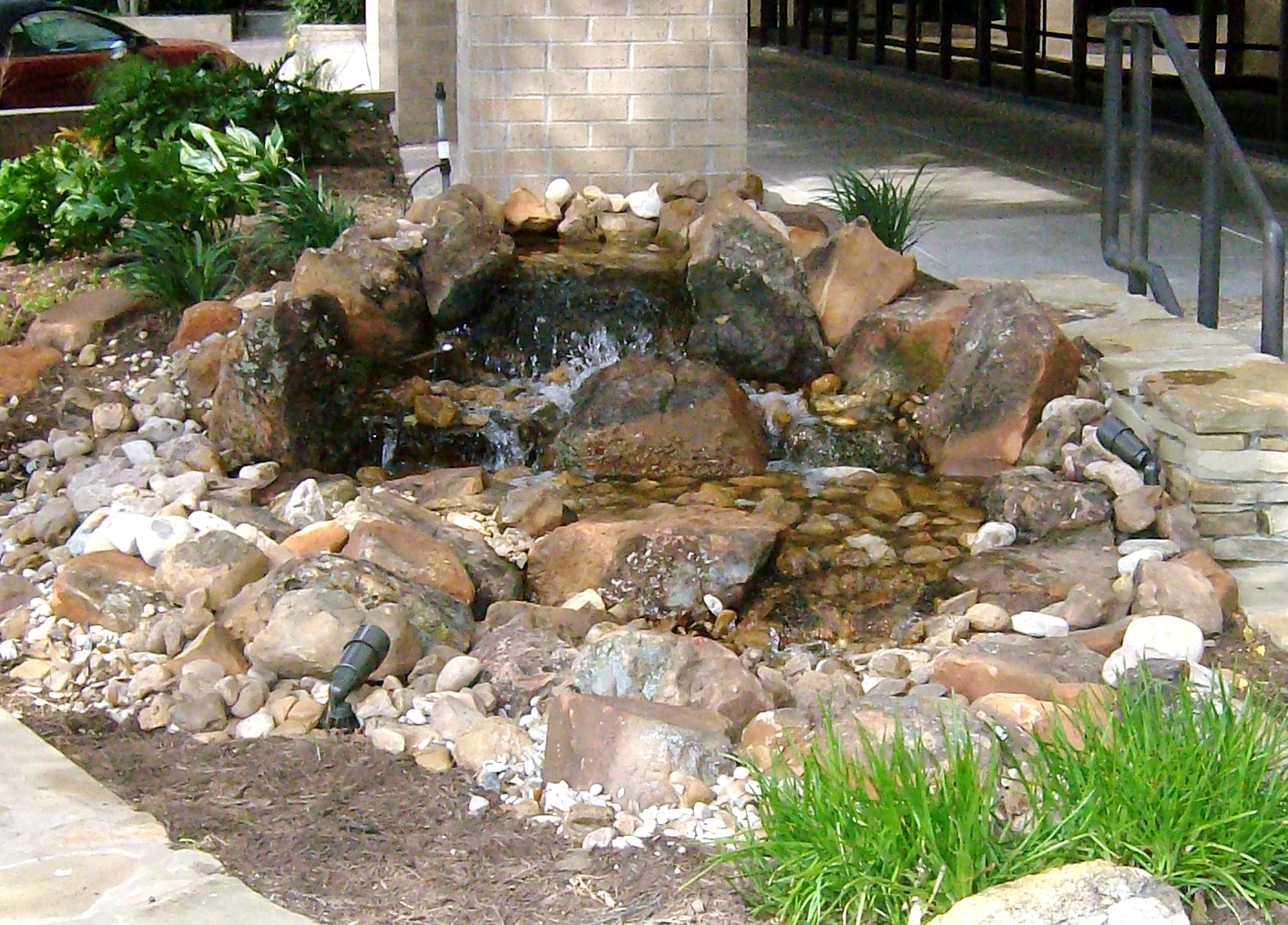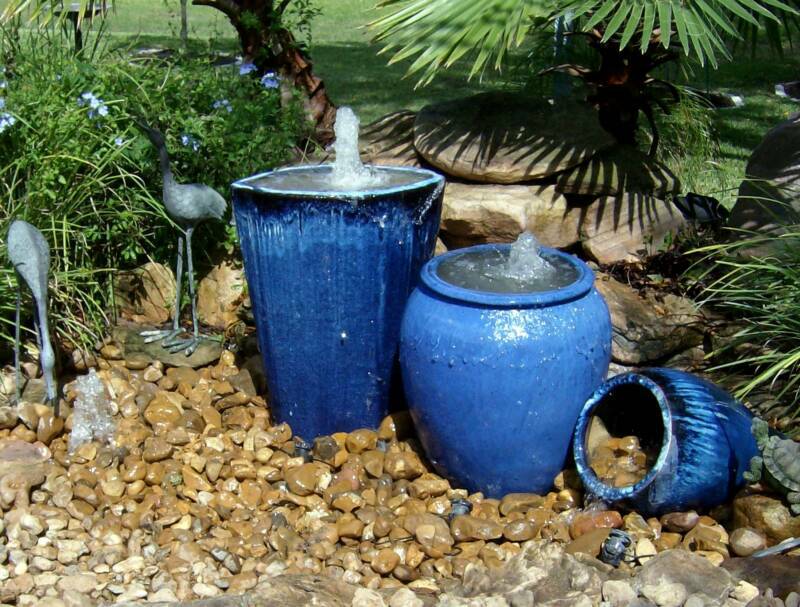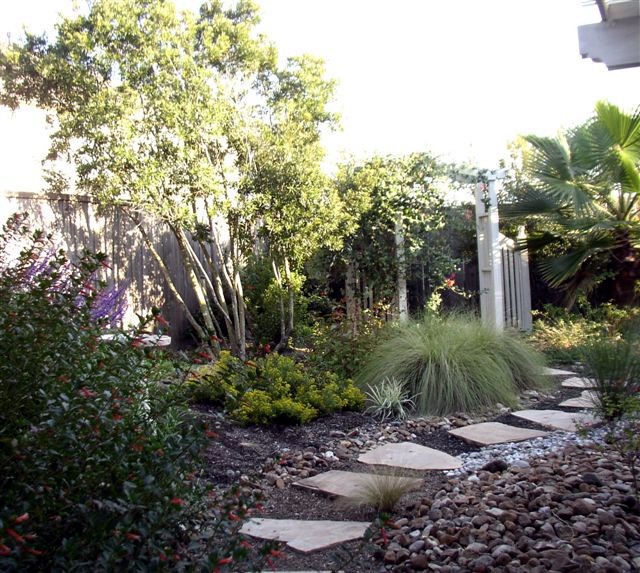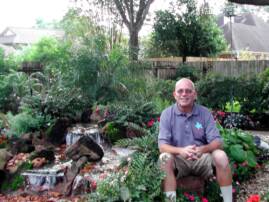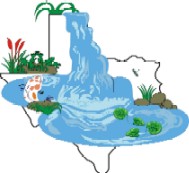


Rainwater Harvesting
Organic Ecosystem Ponds
Pondless Waterfalls
Urn and Fountain Features
Water-Wise Landscapes
Meet Your Water Feature Professionals


Texas Ponds and
Water Features
Planning Your Water Feature
By Matt Boring
The Natural Water Gardener
So you’re thinking about making a splash in your backyard with a water feature. You’re dreaming of the relaxing sound moving water makes as it flows between stones and cascades off of rocks and into a pond. Perhaps you’ve vacationed at a tropical resort with waterfalls in the courtyard or camped beside a gurgling, flowing stream. Maybe you’re fascinated by the Koi ponds at your favorite restaurant or hotel. Or you can’t wait to experiment with the many blooming aquatic plants in the water gardener’s pallette. You might be looking to spruce up the look and curb appeal of your property with a front-yard waterfall. People decide to get water features for many different reasons. I once built a pond for a lady who just wanted a place for her dogs to be able to escape the summer heat!
There are several things to consider before you actually begin your design. The first thing you’ll probably need to think about is your budget for this project. This will help determine whether you can hire a professional to craft your water feature or if this will be a do-it-yourself project. A properly designed and professionally constructed water garden with its surrounding landscape will add value to your property, often more than the cost of the installation. But for the adventurous weekend warrior, installing a pond can be a fun project for the family, or just you and a few buddies. Pond kits take the guesswork out of it for you and the better kits include everything you’ll need to complete your project, even a step-by-step installation DVD.
There is no such thing as a maintenance-free water feature, but organic water gardens, when properly constructed with both a skimmer and a biological filter, are about as close as you can get. I will go into the differences between organic water gardening and traditional methods next month, but for this month, let’s just assume that you’re planning on building an organic or ‘ecosystem pond’. This will provide you with the maximum enjoyment with minimum time spent on maintenance. It also insures a clean healthy environment for your fish and plants as well as practically guaranteeing your water clarity.
If you can afford it, I recommend hiring a professional to design and build your water feature. And beyond that, I recommend hiring a certified professional to do your work. This insures that they have gone through hours and hours of classroom training as well as having a substantial number of ponds under their belt. I’ve been certified for several years now and am still learning new things about ponds and improved construction techniques. Pond building is definitely something that you get better at with practice. Experienced professionals will be able to think of things that you, as a first-time pond builder might not. Perhaps you will end up with water and debris and who knows what washing off your roof and straight into the pond when it rains. Or you want to put your pond in a low spot in your yard and you end up with mulch and other things from your garden washing into the pond whenever there’s a gully washer. It’s better to be able to anticipate a potential problem before the pond’s in the ground than having to deal with the situation later. We also have a little more of a grasp of how water flows on and around the stones and can craft a piece of living artwork that gets better with each passing year.
If you decide to tackle the work yourself, my recommendation is to purchase a complete pond kit rather than trying to piecemeal something together. A proper kit will have everything you need so you don’t end up running to the hardware store three or four times while work comes to a halt. With a kit you can also assume that everything is designed to fit and work properly together. It’s no good to have a big pump if you’re trying to push water through a pipe that won’t handle the volume. The installation DVD is also a big plus. Be sure to buy a kit that includes a skimmer AND a biological filter. The recipe for an ecosystem pond is 1)plants 2)fish 3)biological and mechanical filtration 4)rocks and gravel 5)pumps and plumbing. Remove any of these ingredients and your ecosystem may not balance easily or perhaps at all.
Size will also be a consideration. Your budget may also play a role in this part of your decision as well. My advice is to make your pond as big as you can possibly afford to. The one and only complaint my customers have for me is, “I wish I’d made it bigger.” I’ve heard that too many times to count. While you can always add to the water feature later, it usually ends up costing more than if you’d just had it built that way in the first place. It’s better to start with the pond you want and add the landscape later or in stages. With modern construction techniques and flexible liners, you can do just about whatever you want– ponds with or without waterfalls, waterfalls without ponds, twisting turning streams, multiple waterfalls, underwater tunnels, land bridges, and more. Let your imagination run wild and then make sure your installer shares your vision before beginning. As far as the shape of your feature, it can be just about any shape as well. Wrap it around the corner of your patio to give the illusion of a bigger pond. You can have a waterfall with a sitting area 50 feet away from the pond, connected by a stream, or multiple streams. Just about anything you can dream up, you can do. Hardscapes such as bridges and gazebos open up your options even further.
Location, location, location. Where to put the pond can be a nerve wracking decision, but it’s really not as hard as all that. My motto is, ‘Bring the pond to the residence, don’t make the residents go to the pond. In most cases, I install the pond as close as possible to the area from which it will be viewed the most, be that the patio, deck, balcony, or whatever. You don’t want the water feature collecting runoff water from the roof. Don’t put it in the lowest spot in the yard either. Other than that you can pretty much do what you want. Ecosystem ponds do fine in sun or shade or anything in between.
Here’s a tip for determining your pond’s size, shape and location. Take one or more garden hoses and lay them out in the shape you think looks good. Sit in the main viewing area and make sure you like it. Then go inside and see what the view is from all the windows on the back of the house that face the water feature. Make any changes you like by simply moving the hose. Once you’ve got what you like, call your installer or mark the ground with marking paint and grab some shovels! Your designer may also suggest some things that you hadn’t thought of, such as bringing in soil to create raised areas and then creating streams with multiple drops.
If possible, go on a local pond tour, Parade of Ponds, pond walk, or the like to get additional ideas for your water feature. This gives you a chance to see examples of water features that may help you in planning your own. It also gives you a chance to talk face to face and one on one with actual pond owners. Ask them about their ponding experiences. Ask about maintenance. Ask just about anything. These people have nothing to gain by lying to you. I hold my tour in the late spring. You’ll have to check with your local water gardening community to find a tour schedule for your area, unless you just want to drive out here to visit me and talk ponds. I love to talk ponds and you’d probably be tired of me after a few hours. I’m very passionate about what I do and sometimes can’t seem to shut up about it. Organic water features change people’s lives for the better and I’m so grateful to have a part in that. I love helping reconnect people, even whole families, with nature. Every water feature I make is another chance to create living art, to sculpt moving water, to form something of wonder for not only my client, but their friends and family members for years, even generations to come. I hope you’ll find as much joy in this hobby as I have.
Happy Pondering!!

